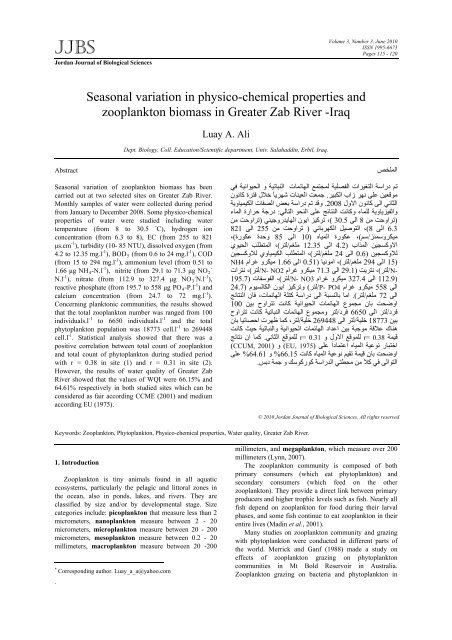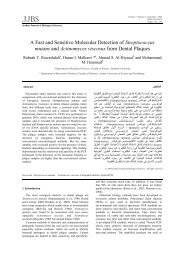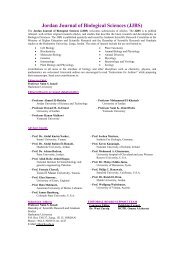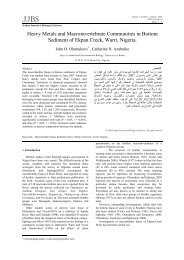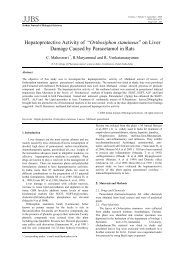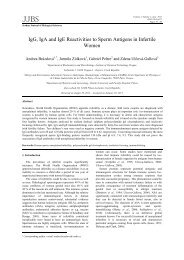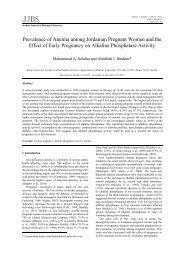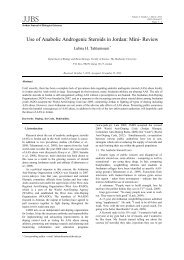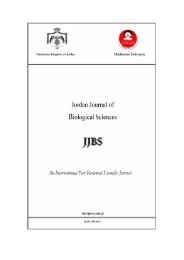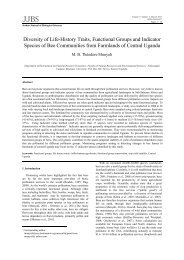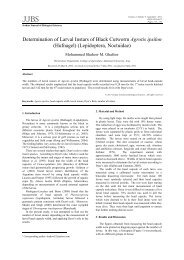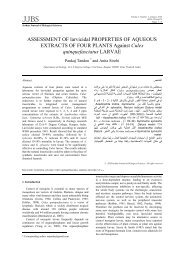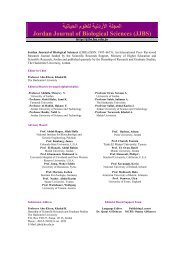Seasonal variation in physico-chemical properties and zooplankton ...
Seasonal variation in physico-chemical properties and zooplankton ...
Seasonal variation in physico-chemical properties and zooplankton ...
You also want an ePaper? Increase the reach of your titles
YUMPU automatically turns print PDFs into web optimized ePapers that Google loves.
JJBS<br />
Jordan Journal of Biological Sciences<br />
Volume 3, Number 3, June 2010<br />
ISSN 1995-6673<br />
Pages 115 - 120<br />
<strong>Seasonal</strong> <strong>variation</strong> <strong>in</strong> <strong>physico</strong>-<strong>chemical</strong> <strong>properties</strong> <strong>and</strong><br />
<strong>zooplankton</strong> biomass <strong>in</strong> Greater Zab River -Iraq<br />
Luay A. Ali<br />
Dept. Biology, Coll. Education/Scientific department, Univ. Salahadd<strong>in</strong>, Erbil, Iraq.<br />
Abstract صخلملا<br />
<strong>Seasonal</strong> <strong>variation</strong> of <strong>zooplankton</strong> biomass has been<br />
carried out at two selected sites on Greater Zab River.<br />
Monthly samples of water were collected dur<strong>in</strong>g period<br />
from January to December 2008. Some <strong>physico</strong>-<strong>chemical</strong><br />
<strong>properties</strong> of water were studied <strong>in</strong>clud<strong>in</strong>g water<br />
temperature (from 8 to 30.5<br />
◦ C), hydrogen ion<br />
concentration (from 6.3 to 8), EC (from 255 to 821<br />
μs.cm -1 ), turbidity (10- 85 NTU), dissolved oxygen (from<br />
4.2 to 12.35 mg.l -1 ), BOD 5 (from 0.6 to 24 mg.l -1 ), COD<br />
(from 15 to 294 mg.l -1 ), ammonium level (from 0.51 to<br />
1.66 μg NH4-N.l -1 ), nitrite (from 29.1 to 71.3 μg NO 2 -<br />
N.l -1 ), nitrate (from 112.9 to 327.4 μg NO 3 - N.l -1 ),<br />
reactive phosphate (from 195.7 to 558 μg PO 4-P.l -1 ) <strong>and</strong><br />
calcium concentration (from 24.7 to 72 mg.l -1 ).<br />
Concern<strong>in</strong>g planktonic communities, the results showed<br />
that the total <strong>zooplankton</strong> number was ranged from 100<br />
<strong>in</strong>dividuals.l -1 to 6650 <strong>in</strong>dividuals.l -1 <strong>and</strong> the total<br />
phytoplankton population was 18773 cell.l -1 to 269448<br />
cell.l -1 . Statistical analysis showed that there was a<br />
positive correlation between total count of <strong>zooplankton</strong><br />
<strong>and</strong> total count of phytoplankton dur<strong>in</strong>g studied period<br />
with r = 0.38 <strong>in</strong> site (1) <strong>and</strong> r = 0.31 <strong>in</strong> site (2).<br />
However, the results of water quality of Greater Zab<br />
River showed that the values of WQI were 66.15% <strong>and</strong><br />
64.61% respectively <strong>in</strong> both studied sites which can be<br />
considered as fair accord<strong>in</strong>g CCME (2001) <strong>and</strong> medium<br />
accord<strong>in</strong>g EU (1975).<br />
Keywords: Zooplankton, Phytoplankton, Physico-<strong>chemical</strong> <strong>properties</strong>, Water quality, Greater Zab River.<br />
1. Introduction *<br />
Zooplankton is t<strong>in</strong>y animals found <strong>in</strong> all aquatic<br />
ecosystems, particularly the pelagic <strong>and</strong> littoral zones <strong>in</strong><br />
the ocean, also <strong>in</strong> ponds, lakes, <strong>and</strong> rivers. They are<br />
classified by size <strong>and</strong>/or by developmental stage. Size<br />
categories <strong>in</strong>clude: picoplankton that measure less than 2<br />
micrometers, nanoplankton measure between 2 - 20<br />
micrometers, microplankton measure between 20 - 200<br />
micrometers, mesoplankton measure between 0.2 - 20<br />
millimeters, macroplankton measure between 20 -200<br />
* Correspond<strong>in</strong>g author. Luay_a_a@yahoo.com<br />
.<br />
يف ةيناويحلا و ةيتابنلا تامئاھلا عمتجمل ةيلصفلا تاريغتلا ةسارد مت<br />
نوناك ةرتف للاخ َايرھش<br />
تانيعلا تعمج . ريبكلا باز رھن ىلع نيعقوم<br />
ةيوايميكلا تافصلا ضعب ةسارد مت<br />
دقو<br />
. 2008 لولاا نوناك ىلا يناثلا<br />
ءاملا ةرارح ةجرد : يلاتلا وحنلا ىلع جئاتنلا تناكو ءاملل ةيوايزيفلاو<br />
نم تحوارت)<br />
ينيجوردياھلا نويا زيكرت ،(<br />
30.5 ىلا 8 نم تحوارت)<br />
821 ىلا 255 نم تحوارت ) يئابرھكلا ليصوتلا ،(<br />
8 ىلا 6.3<br />
،(<br />
ةروكع<br />
ةدحو 85 ىلا 10)<br />
هايملا ةروكع ،(<br />
مس/<br />
زنمسوركيم<br />
يويحلا بلطتملا ،(<br />
رتل/<br />
مغلم 12.35 ىلا 4.2)<br />
باذملا نيجسكولاا<br />
نيجسكولال يوايميكلا بلطتملا ،(<br />
رتل/<br />
مغلم 24 ىلا 0.6)<br />
نيجسكولال<br />
NH4 مارغ وركيم 1.66 ىلا 0.51)<br />
اينوما ،(<br />
رتل/<br />
مغلم 294 ىلا 15)<br />
تارتن ،(<br />
رتل/<br />
N- NO2 مارغ وركيم 71.3 ىلا 29.1)<br />
تيرتن ،(<br />
رتل/<br />
N-<br />
195.7)<br />
تافسوفلا ،(<br />
رتل/<br />
N- NO3 مارغ وركيم 327.4 ىلا 112.9)<br />
24.7)<br />
مويسلاكلا نويا زيكرتو ( رتل/<br />
P- PO4 مارغ وركيم 558 ىلا<br />
جئاتنلا ناف ،تامئاھلا ةلتك ةسارد ىلا ةبسنلاب اما .( رتل/<br />
مغلم 72 ىلا<br />
100 نيب حوارتت تناك ةيناويحلا تامئاھلا عومجم ناب تحضوا<br />
حوارتت تناك ةيتابنلا تامئاھلا عومجمو<br />
رتل/<br />
درف 6650 ىلا رتل/<br />
درف<br />
ناب ايئاصحا ترھظ امك ،رتل/<br />
ةيلخ 269448 ىلا رتل/<br />
ةيلخ 18773 نيب<br />
تناك ثيح ةيتابنلاو ةيناويحلا تامئاھلا دادعا نيب ةبجوم ةقلاع كانھ<br />
جئاتن نا امك . يناثلا عقوملل r= 0.31 و لولاا عقوملل r= 0.38 ةميق<br />
( CCUM, 2001)<br />
و ( EU, 1975)<br />
ىلع َادامتعا<br />
هايملا ةيعون رابتخا<br />
ىلع % 64.61 و % 66.15 تناك هايملا ةيعون ميقت ةميق ناب تحضوا<br />
. سبد ةمج و كسوكروك ةساردلا يتطحم نم لاك يف ىلاوتلا<br />
© 2010 Jordan Journal of Biological Sciences. All rights reserved<br />
millimeters, <strong>and</strong> megaplankton, which measure over 200<br />
millimeters (Lynn, 2007).<br />
The <strong>zooplankton</strong> community is composed of both<br />
primary consumers (which eat phytoplankton) <strong>and</strong><br />
secondary consumers (which feed on the other<br />
<strong>zooplankton</strong>). They provide a direct l<strong>in</strong>k between primary<br />
producers <strong>and</strong> higher trophic levels such as fish. Nearly all<br />
fish depend on <strong>zooplankton</strong> for food dur<strong>in</strong>g their larval<br />
phases, <strong>and</strong> some fish cont<strong>in</strong>ue to eat <strong>zooplankton</strong> <strong>in</strong> their<br />
entire lives (Mad<strong>in</strong> et al., 2001).<br />
Many studies on <strong>zooplankton</strong> community <strong>and</strong> graz<strong>in</strong>g<br />
with phytoplankton were conducted <strong>in</strong> different parts of<br />
the world. Merrick <strong>and</strong> Ganf (1988) made a study on<br />
effects of <strong>zooplankton</strong> graz<strong>in</strong>g on phytoplankton<br />
communities <strong>in</strong> Mt Bold Reservoir <strong>in</strong> Australia.<br />
Zooplankton graz<strong>in</strong>g on bacteria <strong>and</strong> phytoplankton <strong>in</strong>
116<br />
© 2010 Jordan Journal of Biological Sciences. All rights reserved - Volume 3, Number 3<br />
Nakdong River was carried out by Kim et al. (2000) <strong>in</strong><br />
Korea. However, Tan et al. (2004) made an <strong>in</strong>vestigation<br />
on seasonal <strong>variation</strong> <strong>in</strong> <strong>zooplankton</strong> composition <strong>and</strong><br />
graz<strong>in</strong>g impact on phytoplankton <strong>in</strong> Pearl River estuary <strong>in</strong><br />
Ch<strong>in</strong>a. The present <strong>in</strong>vestigation aimed to study the<br />
seasonal <strong>variation</strong>s of <strong>zooplankton</strong> <strong>and</strong> its relations to<br />
phytoplankton, <strong>in</strong> addition to study of some physio<strong>chemical</strong><br />
<strong>properties</strong> <strong>and</strong> water quality of Greater Zab<br />
River.<br />
2. Material <strong>and</strong> Methods<br />
2.1. Study area<br />
Greater Zab River is a large river (392 km) <strong>in</strong> Iraq. This<br />
river is one of the ma<strong>in</strong> tributary of the Tigris. It is<br />
Mosul Lake<br />
Dohuk Lake<br />
43°<br />
0 10<br />
Kilometers<br />
20<br />
Alqush<br />
Tlkef<br />
36°<br />
Zawita<br />
Tigris<br />
Sarsang<br />
Upper Zab<br />
Bartla<br />
Amedi<br />
Khabat<br />
Chamadbz<br />
Kaurgosk<br />
,<br />
The studied <strong>physico</strong>-<strong>chemical</strong> parameters:- water<br />
temperature (by us<strong>in</strong>g precise mercury thermometer),<br />
hydrogen ion concentration (by us<strong>in</strong>g pH-meter), electrical<br />
conductivity (by us<strong>in</strong>g EC-meter), turbidity level (by us<strong>in</strong>g<br />
turbidity-meter), dissolved oxygen (titrimetric methods),<br />
biological <strong>and</strong> <strong>chemical</strong> oxygen dem<strong>and</strong> (titrimetric<br />
methods), ammonium, nitrite <strong>and</strong> nitrate-nitrogen, reactive<br />
phosphate (by us<strong>in</strong>g spectrophotometric methods) <strong>and</strong><br />
calcium ion content(by us<strong>in</strong>g titrimetric methods) were<br />
measured accord<strong>in</strong>g to A.P.H.A. (1998).<br />
Empirical equation was described by (Sanchez et al.,<br />
2007) were used for water quality <strong>in</strong>dex evaluation:-<br />
37°<br />
Shekhan Mergasor<br />
Nahla<br />
Akre<br />
Surchi<br />
A<strong>in</strong> Sfni<br />
Qasruk<br />
Grdas<strong>in</strong><br />
Guer<br />
Bardarash<br />
44°<br />
Fig. (1) Map of Iraq show<strong>in</strong>g the study<strong>in</strong>g sites on Greater Zab River<br />
orig<strong>in</strong>ated ma<strong>in</strong>ly from mounta<strong>in</strong>ous area of Iran <strong>and</strong><br />
Turkey. It is situated between 36 ◦ -37 ◦ north latitudes <strong>and</strong><br />
43 ◦ -44 ◦ east longitude (Susa, 1960). Dur<strong>in</strong>g this study<br />
samples were collected <strong>in</strong> two sites; the first was located<br />
near Kaurgosk village <strong>and</strong> second was located at<br />
Chamadbz village about 20 Km from site one (Fig. 1).<br />
2.2. Sampl<strong>in</strong>g<br />
Samples for physical, <strong>chemical</strong> <strong>and</strong> biological variables<br />
were performed from two sites dur<strong>in</strong>g period extended<br />
from the January to the December 2008. Water samples<br />
were collected for <strong>chemical</strong> <strong>and</strong> biological analysis us<strong>in</strong>g<br />
pre-washed polyethylene bottle by water sample twice<br />
before fill<strong>in</strong>g.<br />
A<strong>in</strong>kaua<br />
Erbil<br />
Bnaslawa<br />
Qushtapa<br />
Salahadd<strong>in</strong><br />
Harir<br />
<br />
<br />
CiPi<br />
i<br />
WQI = k<br />
(1)<br />
Pi<br />
i<br />
Khalifan Raw<strong>and</strong>uz<br />
Shorsh<br />
Soran<br />
Sidakan<br />
Koisnjaq<br />
Betuata<br />
Choman<br />
Balak<br />
Rania<br />
Dukan Lake<br />
∗<br />
Naudasht<br />
Pshdar<br />
Where:<br />
K= is a subjective constant<br />
Ci= is the normalized value of the parameter<br />
Pi= is the relative weight assigned to each<br />
parameter.<br />
The obta<strong>in</strong>ed results of the equation were compared with<br />
the Canadian <strong>and</strong> European st<strong>and</strong>ard for surface water<br />
quality.<br />
Enumeration of phytoplankton was conducted based on a<br />
modification of the membrane filtration technique of<br />
McNabb (1960), H<strong>in</strong>ton <strong>and</strong> Maulood (1979). The<br />
phytoplankton was counted by us<strong>in</strong>g Olympus compound
© 2010 Jordan Journal of Biological Sciences. All rights reserved - Volume 3, Number 3<br />
microscope, the number of algal cell per liter was<br />
calculated by the follow<strong>in</strong>g formula:<br />
Total No. of phytoplankton (cell/l) =<br />
(D * area of filter)/(area of 30 fields * liter of sample<br />
filtered)<br />
D = total count of 30 fields<br />
Zooplankton sample were collected by filter<strong>in</strong>g 30 liter<br />
of the river water us<strong>in</strong>g plankton net (55 µm mesh size),<br />
concentrated sample were fixed with 5% formal<strong>in</strong>.<br />
Count<strong>in</strong>g of <strong>zooplankton</strong> samples was undertaken <strong>in</strong><br />
the laboratory us<strong>in</strong>g a compound microscope <strong>and</strong> the<br />
follow<strong>in</strong>g references were used:-Edmondson (1959),<br />
Scourfield <strong>and</strong> Hard<strong>in</strong>g (1966) <strong>and</strong> Smith (2001). The<br />
results expressed as <strong>in</strong>dividual.l -1 .<br />
2.3. Statistical analysis:<br />
Statistical analysis of <strong>physico</strong>-<strong>chemical</strong> data was done<br />
us<strong>in</strong>g Completely R<strong>and</strong>omized Design (CRD) to study the<br />
effect of different site <strong>and</strong> date of sampl<strong>in</strong>g, <strong>and</strong> LSD<br />
values were calculated to compare between each of<br />
ecological data. Also, simple correlation analysis was done<br />
between total count of <strong>zooplankton</strong> <strong>and</strong> total count of<br />
phytoplankton (Snedecor <strong>and</strong> Cochran, 1980).<br />
3. Results:-<br />
In this study, a number of phisco-<strong>chemical</strong> parameters<br />
were studied (Table 1). Water temperature of studied sites<br />
dur<strong>in</strong>g studied period was ranged between 8 to 30 ◦ C, <strong>and</strong><br />
statistically the regional <strong>and</strong> monthly <strong>variation</strong> showed non<br />
significant differences (p< 0.05).<br />
Hydrogen ion concentration of studied river <strong>in</strong> studied<br />
sites was ranged from 6.3 to 8. Statistical analysis showed<br />
that pH value was significantly different (P< 0.05)<br />
between studied sites <strong>and</strong> date of sampl<strong>in</strong>g.<br />
Electrical conductivity of studied sites ranged between<br />
255 to 821 µs.cm -1 , <strong>and</strong> the results showed that there was a<br />
significant difference (P< 0.05) between studied sites <strong>and</strong><br />
time of sampl<strong>in</strong>g.<br />
Turbidity levels revealed that they were obviously<br />
significant differences (p
118<br />
Tota phytoplankton cell x10/l<br />
Total phytoplankton cell x10 /l<br />
25000<br />
20000<br />
15000<br />
10000<br />
5000<br />
0<br />
© 2010 Jordan Journal of Biological Sciences. All rights reserved - Volume 3, Number 3<br />
Jan. Feb. Mar. Apr. May Jun. jul. Aug. Sep. Oct. Nov. Des.<br />
Monthes<br />
Fig. (2)Relationship between total <strong>zooplankton</strong> <strong>and</strong> total phytoplankton <strong>in</strong> site<br />
(1) dur<strong>in</strong>g study period<br />
30000<br />
25000<br />
20000<br />
15000<br />
10000<br />
5000<br />
0<br />
Total phytoplankton Total <strong>zooplankton</strong><br />
Total phytoplankton Tota <strong>zooplankton</strong><br />
Jan. Feb. Mar. Apr. May Jun. jul. Aug. Sep. Oct. Nov. Des.<br />
Monthes<br />
Fig. (3)Relationship between total <strong>zooplankton</strong> <strong>and</strong> total phytoplankton <strong>in</strong><br />
Chamadbz dur<strong>in</strong>g study period<br />
7000<br />
6000<br />
5000<br />
4000<br />
3000<br />
2000<br />
1000<br />
0<br />
7000<br />
6000<br />
5000<br />
4000<br />
3000<br />
2000<br />
1000<br />
0<br />
Total <strong>zooplankton</strong> <strong>in</strong>dividual/l<br />
Total <strong>zooplankton</strong> <strong>in</strong>dividual/l
WQI (%)<br />
4. Discussion:-<br />
67<br />
66.5<br />
66<br />
65.5<br />
65<br />
64.5<br />
64<br />
63.5<br />
63<br />
62.5<br />
© 2010 Jordan Journal of Biological Sciences. All rights reserved - Volume 3, Number 3<br />
Site 1 Site 2<br />
Fig. (4) Water quality <strong>in</strong>dex <strong>in</strong> Greater Zab River (value as mean)<br />
Water temperature is an important factor <strong>in</strong> any aquatic<br />
environments affect<strong>in</strong>g on biological processes, <strong>in</strong> this<br />
study it was ranged between 8 to 30.5 ◦ C. This <strong>variation</strong><br />
may be due to changes <strong>in</strong> air temperature, <strong>and</strong> this result<br />
was similar to previous studies done by Ali (2007) <strong>and</strong><br />
Shekha (2008). The pH value of Greater Zab River <strong>in</strong><br />
study sites dur<strong>in</strong>g of most studied period was alkal<strong>in</strong>e side<br />
above 7, <strong>and</strong> this result agreed with Maulood et al. (1980)<br />
they reported that Iraqi <strong>in</strong>l<strong>and</strong> water is regarded to be on<br />
the alkal<strong>in</strong>e side of neutrality, reflect<strong>in</strong>g geological<br />
formations of the area <strong>and</strong> the results are agree with the<br />
f<strong>in</strong>d<strong>in</strong>g that recorded by Ali (2007) <strong>and</strong> Shekha (2008) <strong>in</strong><br />
the same river. Electrical conductivity used as an <strong>in</strong>dicator<br />
of water quality based on total dissolved salts (Rasheed,<br />
1994). Generally, EC value was less than 500 μs.cm -1 <strong>in</strong><br />
most of studied period <strong>in</strong> both sites <strong>and</strong> the results came <strong>in</strong><br />
accordance with the known EC value for Iraqi <strong>in</strong>l<strong>and</strong> water<br />
(Al-Naqshb<strong>and</strong>i, 2002). On the other h<strong>and</strong>, lower level of<br />
turbidity was 10 NTU recorded <strong>in</strong> June, while the higher<br />
level was observed dur<strong>in</strong>g september 2008 which may be<br />
due to the <strong>in</strong>crease of planktonic algal growth (Anto<strong>in</strong>e<br />
<strong>and</strong> Alsaadi, 1982).<br />
Oxygen content of water is one of the important<br />
factors, <strong>and</strong> it is very necessary for all liv<strong>in</strong>g organisms<br />
(WHO, 2006). The DO content of studied river was ranged<br />
between 4 to4- 12.35 mg.l -1 . However, BOD 5 <strong>and</strong> COD<br />
values were ranged between 0.6 – 24 mg.l -1 <strong>and</strong> 15 – 294<br />
mg.l -1 , respectively. Generally, high value of BOD 5 <strong>and</strong><br />
COD were observed dur<strong>in</strong>g the warm sommer months<br />
(July <strong>and</strong> August) which co<strong>in</strong>cided with a high water<br />
temperature <strong>and</strong> low DO. These results were slightly lower<br />
than that reported by Shekha (2008) at the same river.<br />
Ammonium nitrogen is commonly used as an <strong>in</strong>dicator<br />
for organic matter content, while nitrite is another source<br />
of <strong>in</strong>organic nitrogen <strong>and</strong> concern<strong>in</strong>g as an <strong>in</strong>dicator of<br />
water pollution. The high level of nitrite may be due to<br />
domestic sewage <strong>in</strong>put to the river from the surround<strong>in</strong>g<br />
village. Nitrate is the stable form of comb<strong>in</strong>ed nitrogen <strong>and</strong><br />
it is an important factor which might limit growth of<br />
119<br />
phytoplankton (ref….). The results of ammonia, nitrite <strong>and</strong><br />
nitrate nitrogen are agreed with those of Ali (2007) <strong>and</strong><br />
Shekha (2008). Phosphorus is essential to the growth of<br />
algae <strong>and</strong> other biological organisms. The reactive<br />
phosphate concentration <strong>in</strong> studied river was ranged<br />
between 195.7 to 558 μg PO4-P.l -1 . The high concentration<br />
of phosphate may be due to sewage water effluent <strong>and</strong><br />
fertilizer application <strong>in</strong> surround<strong>in</strong>g agricultural area. This<br />
result was close to that reported by Shekha (2008).<br />
Calcium concentration <strong>in</strong> the studied Zab was ranged from<br />
24.7 72 mg.l -1 . The present result was similar to that<br />
reported by Ali (2007), <strong>and</strong> it was lower than that reported<br />
by Al-Kubasi (1996).<br />
Concern<strong>in</strong>g to phytoplankton community, the results<br />
showed that the range of total phytoplankton population<br />
was 18773 cell.l -1 to 269448 cell.l -1 . Diatoms were the<br />
most dom<strong>in</strong>ant group of phytoplankton <strong>in</strong> the studied river,<br />
with dom<strong>in</strong>ancy of Cyclotella sp. <strong>in</strong> both sites. The total<br />
<strong>zooplankton</strong> population was from 100 <strong>in</strong>dividual.l -1 to<br />
6650 <strong>in</strong>dividual.l -1 with mean value of 3266.7 ± 95.24x10 3<br />
<strong>in</strong>dividuals.l -1 <strong>in</strong> site (1) <strong>and</strong> 2782.1 ± 102.01x10 3<br />
<strong>in</strong>dividual.l -1 <strong>in</strong> site (2), which was lower to the value<br />
reported by Ahmed et al. (2004) <strong>and</strong> Chowdhury et al.<br />
(2007). Crustacea was dom<strong>in</strong>ant group among <strong>zooplankton</strong><br />
especially Copepods with the dom<strong>in</strong>ancy of Eucyclops sp.<br />
<strong>in</strong> both sites dur<strong>in</strong>g studied period. Similarly Patra <strong>and</strong><br />
Azadi (1987) reported same result <strong>in</strong> Hulda River <strong>and</strong> Ali<br />
(2007) <strong>and</strong> Shekha (2008) also reported similar results <strong>in</strong><br />
the greater Zab River. In site (1) <strong>zooplankton</strong> showed two<br />
ma<strong>in</strong> peaks, one extended from March to May <strong>and</strong> another<br />
one <strong>in</strong> November. In site (2) the first peak was <strong>in</strong> April to<br />
June the other one from October to November. The lower<br />
value of <strong>zooplankton</strong> was 100 <strong>in</strong>dividual.l -1 observed <strong>in</strong><br />
site (2) dur<strong>in</strong>g January 2008, <strong>and</strong> this may be due to<br />
decrease of phytoplankton number <strong>in</strong> which <strong>zooplankton</strong><br />
graz<strong>in</strong>g on it, <strong>in</strong> addition to low temperature dur<strong>in</strong>g cold<br />
w<strong>in</strong>ter months. These results agreed with those results<br />
reported by Das <strong>and</strong> Srivastava (1956) <strong>in</strong> a pond <strong>in</strong> India<br />
<strong>and</strong> Chowdhury et al. (2007) <strong>in</strong> Borobila beel. Razzaque et<br />
al. (1995) reported that the <strong>zooplankton</strong> showed two<br />
peaks, one <strong>in</strong> the May <strong>and</strong> another <strong>in</strong> the October <strong>in</strong> Halti<br />
Beel. Both <strong>zooplankton</strong> <strong>and</strong> phytoplankton showed direct
120<br />
© 2010 Jordan Journal of Biological Sciences. All rights reserved - Volume 3, Number 3<br />
graz<strong>in</strong>g relationship with r = 0.38 <strong>in</strong> Kaurgosk <strong>and</strong> r = 0.31<br />
<strong>in</strong> Chamadbz (Fig. 2, 3). Similar relationship was also<br />
reported by Ali et al. (1985) <strong>in</strong> a Lucknow pond <strong>in</strong> India,<br />
Patra <strong>and</strong> Azadi (1987) <strong>in</strong> Halda River, Chowdhury et al.<br />
(2007) <strong>in</strong> Borobila Beel.<br />
The results of the seasonal <strong>variation</strong> <strong>in</strong> <strong>zooplankton</strong><br />
population suggest that the most favourable period for<br />
growth is from the August to the November, <strong>and</strong> this may<br />
be due to <strong>in</strong>crease of phytoplankton population. The same<br />
phenomenon was reported by Razzaque et al. (1995) <strong>and</strong><br />
Ehshan et al. (2000).<br />
Regard<strong>in</strong>g to the evaluation of the water quality with<br />
us<strong>in</strong>g of WQI, the results showed that the values of WQI<br />
were 66.15% <strong>in</strong> site (1) <strong>and</strong> decreased to 64.61% <strong>in</strong><br />
Chamadbz. Tak<strong>in</strong>g <strong>in</strong> to account both the po<strong>in</strong>ts sampled,<br />
the water from Greater Zab River may be classified as fair<br />
(Grade D) depend<strong>in</strong>g on the classification of CCME<br />
(2001), meanwhile accord<strong>in</strong>g to EU (1975) classification<br />
of water of both sites can be regarded as medium (Fig. 4).<br />
Further study should be conducted on seasonal<br />
<strong>variation</strong> of <strong>zooplankton</strong> <strong>and</strong> phytoplankton <strong>in</strong> relation to<br />
some other parameters as water temperature, nutrients <strong>and</strong><br />
pollution should be taken <strong>in</strong> Greater Zab River.<br />
References<br />
Ahmed K K U, Hasan K R, Ahamed S U, <strong>and</strong> Mustafa G. 2004.<br />
Ecology of Shakla beel (Brahmanbaria), Bangladesh. Bangladesh<br />
J. Fish. Res. 8(2): 101-111.<br />
Ali L A. 2007. A study of macro<strong>in</strong>vertebrates community <strong>in</strong> the<br />
middle sector of Greater Zab River, Iraq. Ph.D. Thesis. Univ. of<br />
Baghdad. Iraq.<br />
Ali M M, Islam M A, <strong>and</strong> Habib M A B. 1985. Monthly<br />
abundance of <strong>zooplankton</strong> <strong>and</strong> correlation of various dom<strong>in</strong>ant<br />
species <strong>and</strong> nauplius of <strong>zooplankton</strong> with some water characters <strong>in</strong><br />
a pond. Univ. J. Zool. Rajshahi Univ. 4: 42-49.<br />
Al-Kubasi A A. 1996. Ecological events of Sadam River. Ph. D.<br />
Thesis, Univ. of Baghdad. (<strong>in</strong> Arabic)<br />
Al-Naqshb<strong>and</strong>i L M A. 2002. Limnological studies on the water<br />
treatment plant <strong>in</strong> Efraz, Erbil, Iraqi Kurdistan Region. Iraq. M.Sc.<br />
Thesis, Univ. of Salahadd<strong>in</strong> – Erbil, Iraq.<br />
American Public Health Association (A.P.H.A.). 1998. St<strong>and</strong>ard<br />
methods for the Exam<strong>in</strong>ation of water <strong>and</strong> wastewater, 20 th<br />
Edition. A.P.H.A.,1015 Fifteenth Street, NW, Wash<strong>in</strong>gton, DC.<br />
Anto<strong>in</strong>e S E, <strong>and</strong> Al-Saadi H A. 1982. Limnological studies on<br />
the polluted Ashar canal <strong>and</strong> Shatt Al-Arab River at Basrah, Iraq.<br />
Int. Rev. Ges. Hydrobiologia. 67(3): 405-418.<br />
Canadian Council of M<strong>in</strong>isters of the Environment (CCME).<br />
2001. Canadian water quality guidel<strong>in</strong>es for the protection of<br />
aquatic life: CCME, Water Quality Index. 1, Users Manual.<br />
W<strong>in</strong>nipeg.<br />
Chowdhury M M R, Mondol M R K, <strong>and</strong> Sarker C. 2007.<br />
<strong>Seasonal</strong> <strong>variation</strong> of plankton population of Borobila beel <strong>in</strong><br />
Rangpur district. Univ. J. Zool. Rajshahi Univ. 26: 49-54.<br />
Das S A, <strong>and</strong> Srivastava V K. 1956. Quantitative on freshwater<br />
plankton of a fish tank <strong>in</strong> Lucknow, India. Proc. Nat. Acad. Soc.<br />
India 26: 85-91.<br />
Edmondson W T. 1959. Freshwater biology. Johan Wiley <strong>and</strong><br />
Sons, Inc. 2 ed Ed., 1248pp.<br />
Ehshan M A, Hossa<strong>in</strong> M S, Razzaque A, <strong>and</strong> Alam M S. 2000.<br />
Kua-an unusual but important fishery of Ch<strong>and</strong>a beel. Bangladesh<br />
J. Zool. 28(1): 69-74.<br />
European Union (EU). 1975. Council Directive 75/440/EEC of 15<br />
June 1975 concern<strong>in</strong>g the quality required of surface water<br />
<strong>in</strong>tended for the abstraction of dr<strong>in</strong>k<strong>in</strong>g water <strong>in</strong> the member<br />
states. Official J. L. 194, 0026- 0031.<br />
H<strong>in</strong>ton G C F, <strong>and</strong> Maulood B K. 1979. Fresh water diatoms from<br />
Suliamanyah, Iraq. Nova. Hedwigia. 31: 449-466.<br />
Kim H W, Hwang S J, <strong>and</strong> Joo G J. 2000. Zooplankton graz<strong>in</strong>g on<br />
bacteria <strong>and</strong> phytoplankton <strong>in</strong> a regulated large river (Nakdong<br />
River, Korea). J. of Plankton Res. 22(8): 1559 – 1577.<br />
Lynn D H. 2007. The ciliated protozoa, characterization,<br />
classification, <strong>and</strong> guide to the literature. 3 ed edition. Juoiter<br />
Images Corporation. Canada. 605pp<br />
Mad<strong>in</strong> L P, Horgan E F, <strong>and</strong> Ste<strong>in</strong>berg D K. 2001. Zooplankton at<br />
the Bermuda Atlantic Time-series Study (BATS) station: diel,<br />
seasonal <strong>and</strong> <strong>in</strong>terannual <strong>variation</strong> <strong>in</strong> biomass, 1994-1998. Deep-<br />
Sea Res. 48(8-9): 2063-2082.<br />
Maulood B K, H<strong>in</strong>ton G C F, <strong>and</strong> Al-Dosky H S. 1980. A study<br />
on the blue green algal flora of Arbil prov<strong>in</strong>ce, Iraq. Zanco Sci. J.<br />
Univ. Sulaimaniyah, Iraq, 6:67-90.<br />
McNabb C D. 1960. Enumeration of fresh water phytoplankton<br />
concentrated on the membrane filter. Limnol. Oceangr. 5: 57-61.<br />
Merrick C J, <strong>and</strong> Ganf G G. 1988. Effects of <strong>zooplankton</strong><br />
communities <strong>in</strong> Mt Bold reservoir, South Australia, us<strong>in</strong>g<br />
enclosures. Australian J. of Mar<strong>in</strong>e <strong>and</strong> Freshwater Res. 39(4):<br />
503-523.<br />
Patra R W R, <strong>and</strong> Azadi M A. 1987. Ecological studies on the<br />
planktonic organisms of the Halda River. Bangladesh J. Zool.<br />
15(2): 109-123.<br />
Rasheed R O. 1994. A limnological study on some water systems<br />
<strong>in</strong> Erbil prov<strong>in</strong>ce. Iraq. M.Sc. Thesis. Univ. of Salahadd<strong>in</strong>-Erbil,<br />
Iraq.<br />
Razzaque A, Hossa<strong>in</strong> M S, Islam A K M S, Hossa<strong>in</strong> M M M, <strong>and</strong><br />
Ehshan M A. 1995. Study on plankton population of Halti beel at<br />
Natore, Bangladesh. Bangladesh J. Aquaculture, 17: 19-23.<br />
Sanchez E, Colmenarejo M F, Vicente J, Rubio A, Garcia MG,<br />
Travieso L, <strong>and</strong> Borja R. 2007. Use of the water quality <strong>in</strong>dex <strong>and</strong><br />
dissolved oxygen deficit as simple <strong>in</strong>dicators of watersheds<br />
pollution. Ecol. Indic., 7:315- 328.<br />
Scourfield D J, <strong>and</strong> Hard<strong>in</strong>g J P. 1966. A key to the British<br />
Freshwater Cladocera, with notes on their Ecology. Freshwater<br />
Biological Association, Sci. Pub., No. 5, 3 ed Edition. 55pp.<br />
Shekha Y A. 2008. The effect of Erbil city wastewater discharge<br />
on water quality of Greater Zab River, <strong>and</strong> the risks of irrigation.<br />
Ph. D. Thesis. Univ. of Baghdad. Iraq.<br />
Smith D G. 2001. Pennak’s Freshwater Invertebrates of the United<br />
Stares. John Wiley &Sons, Inc. USA. 638p.<br />
Sendecor W G, <strong>and</strong> Cochran G W. 1980. Statistical methods. 7 th<br />
Ed. The Lowa State Univ. Press, U.S.A.<br />
Susa A. 1960. Iraqi geographic <strong>in</strong>dex. Diar Al-tamadun press,<br />
Baghdad. 61p.<br />
Tan Y, Huang L, Chen Q, <strong>and</strong> Huang X. 2004. <strong>Seasonal</strong> <strong>variation</strong><br />
<strong>in</strong> <strong>zooplankton</strong> composition <strong>and</strong> graz<strong>in</strong>g impact on phytoplankton<br />
st<strong>and</strong><strong>in</strong>g stock <strong>in</strong> the Pearl River estuary, Ch<strong>in</strong>a. Cont<strong>in</strong>ental shelr<br />
Res. 24(16): 1949 – 1968.<br />
World Health Organization (WHO). 2006. Guidel<strong>in</strong>es for the safe<br />
use of wastewater, excreta <strong>and</strong> gray water: Wastewater use <strong>in</strong><br />
agriculture. Volume II. France: 222pp.


